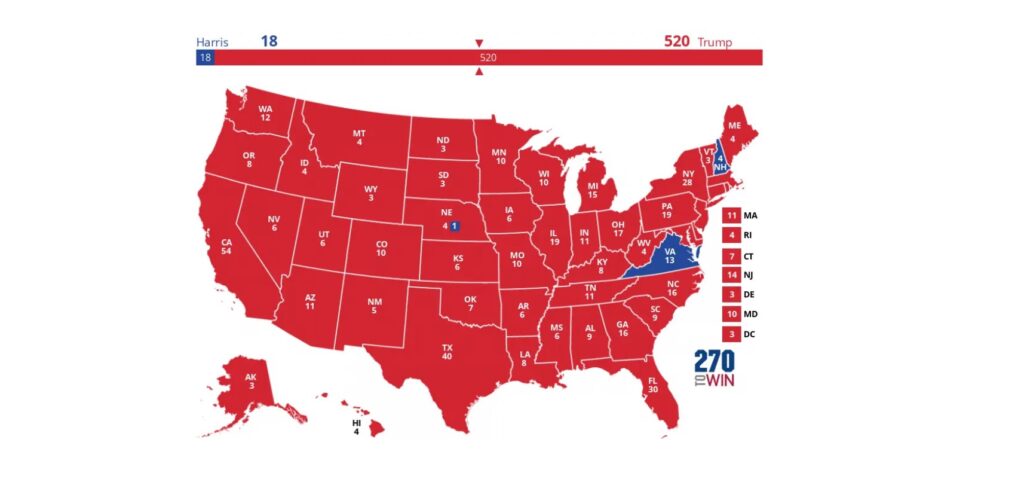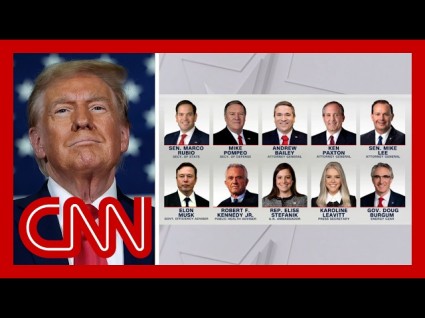ARTICLE AD BOX
Imagine President-elect Donald Trump carrying New York and California and sweeping New England and other blue states to rack up 520 votes in the Electoral College.
Ironically, it could have happened if a movement largely funded by left-leaning organizations got its way.
Already, 17 states and the District of Columbia have joined the National Popular Vote Interstate Compact, agreeing to allocate their electoral votes to whichever presidential candidate wins the national popular vote—regardless of which candidate wins a majority of the state’s vote.
That membership has a total of 209 electoral votes, within striking distance of the 270 needed for the compact to snap into effect. (A tally of 270 votes or more in the Electoral College is what elects a president.)
The interstate compact still needs enough states to produce 61 more votes and reach 270 before states would be bound to the interstate agreement.
As of Friday morning, Trump had 312 electoral votes to 226 for Kamala Harris, according to the website 270 to Win. Harris won all 17 states, plus D.C., that already are part of the compact. Those states and the nation’s capital would have had to give their electoral votes to Trump under the agreement.
Voters in blue states that joined the compact wouldn’t likely be pleased with this scenario, said Trent England, executive director of Save Our States, which opposes the proposed popular vote compact.
“What you would likely see if this happened is a Democratic voter in California would sue in state court and find a partisan judge, and one state court decision could unravel the entire compact,” England told The Daily Signal.
England posted an article showing an almost entirely red map signifying Trump wins, with the headline: “Trump Wins 520 Electoral Votes?”

National Popular Vote, a bipartisan national nonprofit organization, advocates that all states join the compact. The group includes some prominent Republicans, although it is mostly funded by left-leaning organizations.
The largest of these donors is Democracy Fund Voice, which contributed $400,000 in 2022. Democracy Fund Voice is a left-leaning lobbying group that is part of the advocacy network of eBay founder Pierre Omidyar.
Other left-leaning organizations that have funded National Popular Vote include the Jennifer and Jonathan Allan Soros Foundation, the Stephen M. Silberstein Foundation, and the Tides Foundation.
So, arguably, if these funders had their way, Trump would have won an Electoral College landslide in Tuesday’s election that is comparable to those of Ronald Reagan, Richard Nixon, and Franklin Roosevelt.
A National Popular Vote spokesperson didn’t respond to phone and email inquiries Friday from The Daily Signal. But the organization has said it’s a myth that going to a national popular vote to elect a president would advantage Democrats over Republicans.
“The cumulative nationwide presidential vote for the two parties in the 20 presidential elections between 1932 and 2008 has been virtually tied—a grand total of 746,260,766 votes for the Democrats and 745,502,654 for the Republicans,” NPV’s website says.
It later adds: “Contrary to political mythology, the Republican Party gains no partisan advantage from the 13 smallest states (i.e., those with three or four electoral votes) under the current state-by-state, winner-take-all system. In the six presidential elections between 1992 and 2012, the 13 smallest states have divided 7-6 in favor of the Democrats four times, 8-5 in favor of the Democrats once, and 7-6 in favor of the Republicans once.”
The Heritage Foundation published an ebook, “The Essential Electoral College,” which defends the traditional system for picking a president.
“The Electoral College prevents presidential candidates from winning an election by focusing solely on high-population urban centers and dense media markets, forcing them to seek the support of a larger cross-section of the American electorate,” Heritage’s publication argues. “This addresses the Founders’ fears of a ‘tyranny of the majority,’ which has the potential to marginalize sizable portions of the population, particularly in rural and more remote areas of the country.”
Save Our States’ England said he anticipates that many Democrats in states that belong to the agreement might question their lawmakers about remaining in it.
“The compact was started on partisan sour grapes on a belief by some Democrats that Republicans couldn’t win the popular vote,” England said. “It’s not just that Trump won the popular vote this year. But I think more people are becoming aware that battleground states have been expanding and shifting in the last 20 years.”
The post Here’s What Would Have Happened Election Day If Popular Vote Compact Had Been in Effect appeared first on The Daily Signal.
.png)
 1 week ago
1
1 week ago
1








 English (US)
English (US)